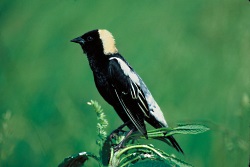
Dolichonyx oryzivorus
Courtesy: U.S. Fish & Wildlife Service
Steve Maslowski, Photographer
Washington Irving called the bobolink “the happiest bird of our spring and added that his life seems all song and sunshine”. Emily Dickinson called the bobolink “the rowdy of the meadow for its bubbly, jangling song”. It was immortalized by nineteenth-century American poet William Cullen Bryant, in a poem titled Robert of Lincoln.
Singing on the wing, the bobolinks song can be over ten seconds long with more than one hundred phrases, a remarkable feet! Their lungs are much more efficient than ours. It can store oxygen in air sacs, and as air is exhaled to produce song, the air sacs deliver fresh oxygen to the lungs.
Bobolinks migration is no less remarkable. They return from the tropics each spring, having completed one of the longest migrations of any songbird in the Americas: roughly six thousand miles. Bobolinks fly from northern Argentina to the northern US and Canada. They cross all sorts of hazardous terrain and hundreds of miles of open water. Like many birds, they rely on cues from the stars and sun and from landmarks on the earth to guide them. Additionally, they can sense the earth’s mineral magnetite, thanks to iron oxide in bristles of its nasal cavity and in tissues around the olfactory bulb and nerve.
Alarmingly, like its European cousin, bobolinks have declined in numbers on its North American breeding grounds by over 60% since 1970. It is a Species of Greatest Conservation Concern in most U.S. states and Canadian provinces in which it occurs, and is listed as Threatened under the Species at Risk Act in Canada. Populations are predicted to decline by 30% over the next two decades from habitat loss aggravated by a changing climate.
People have shot Bobolinks as agricultural pests, trapped and sold them as pets in Argentina, and collected them as food in Jamaica. But the main reason for the Bobolink’s decline is land-use change, especially the loss of meadows and hay fields. To improve the Bobolink’s prospects, people can maintain its breeding habitat by mowing fields once nestlings have fledged, by preserving and better managing natural prairies through prescribed burns.
The skylark is facing a stark future in Europe as well. Only 10% remains compared to 1960 numbers. Farmers are being paid to create habit for this iconic bird, perhaps something we should consider for the bobolink.
One of the few breeding populations in Cache Valley exists in an area being threatened with a proposed housing development. We are hopeful the planners will allow this struggling bird species to continue on as their planning proceeds.
Jack Greene for Bridgerland Audubon Society, and I’m wild about Utah’s bobolinks!
Credits:
Nest Picture: Courtesy US FWS, Steve Maslowski, Photographer
Audio: Courtesy and Copyright Kevin Colver, https://wildstore.wildsanctuary.com/collections/special-collections/kevin-colver
Text: Jack Greene, Bridgerland Audubon, https://bridgerlandaudubon.org/
Additional Reading: Lyle W Bingham, Webmaster, and Jack Greene, Author, Bridgerland Audubon, https://bridgerlandaudubon.org/
Additional Reading:
Jack Greene’s Postings on Wild About Utah, https://wildaboututah.org/author/jack/
Bobolink Overview, All About Birds, Cornell Lab of Ornithology, Cornell University, https://www.allaboutbirds.org/guide/Bobolink/overview
Bobolink, Bird of the Week: September 18, 2020, American Bird Conservancy, https://abcbirds.org/bird/bobolink/?gclid=CjwKCAjwrPCGBhALEiwAUl9X058HMZvoFUELlV1kLrB2bv5wMytW2sDIUqOJgD7OYkHDilr3BfqVRRoCgkoQAvD_BwE
Bobolink, Species, eBird, https://ebird.org/species/boboli/L941919
Strand, Holly, Spring Migration, Wild About Utah, https://wildaboututah.org/spring-migration/
Renfrew, R.B., K.A. Peters, J.R. Herkert, K.R. VanBeek, and T. Will. 2019. A full life cycle
conservation plan for Bobolink (Dolichonyx oryzivorus). U.S. Fish & Wildlife Service., https://partnersinflight.org/wp-content/uploads/2019/07/A-Full-Life-Cycle-Conservation-Plan-for-Bobolink.pdf
The Bobolink Project, A research study developed by researchers at the University of Rhode Island, the University of Connecticut, and the University of Vermont. Administered by Mass Audubon, Audubon Vermont, and New Hampshire Audubon, https://www.bobolinkproject.com/
Bobolink Habitat, Advocacy, Our Projects, Bridgerland Audubon, https://bridgerlandaudubon.org/our-projects/advocacy/bobolink-habitat/
